July 11th, 2013 §
I’m getting tired of writing about chicks, and you’re probably tired of reading about them. So let’s investigate this totally uninteresting gas tank, which sits by my chimney and powers my stove.
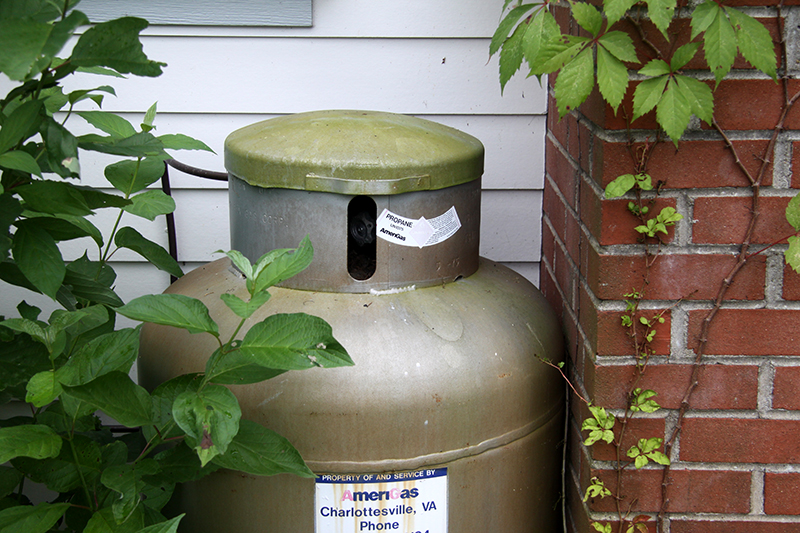
Hark, what’s this?
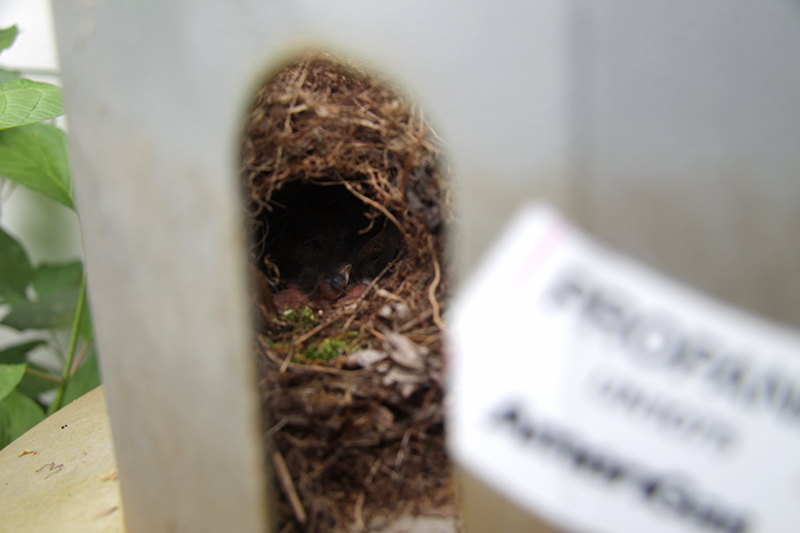
Let’s lift the lid and see.
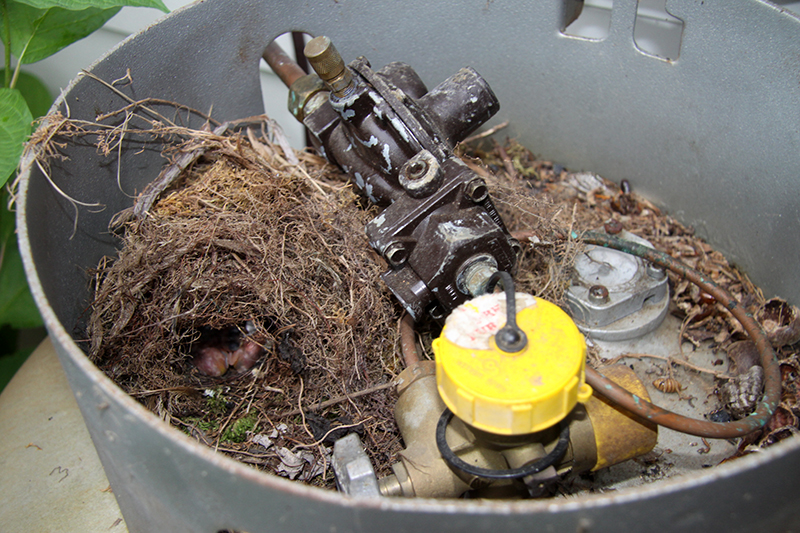
Gah! More chicks! They’re everywhere!
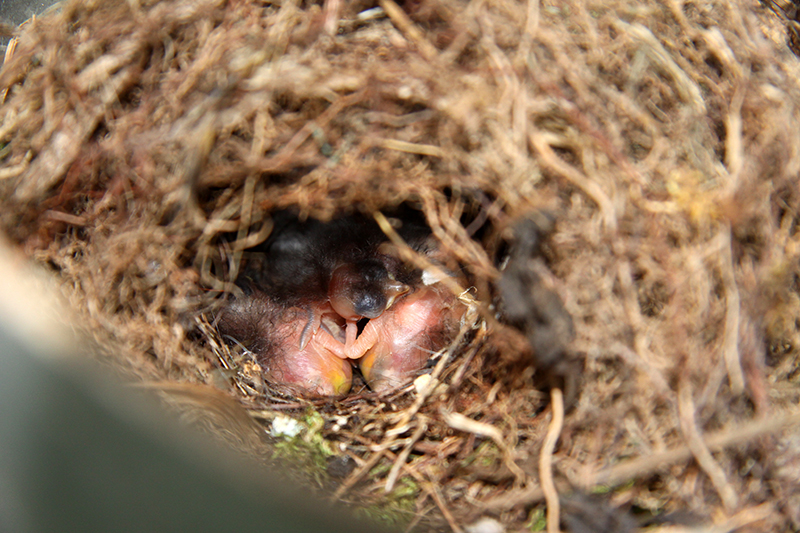
These are little wren babies. The gig was up today when I saw their parent fly out of the tank. So many chicks, all over the place. I’m going crazy, hearing peeping noises inside my head. Yesterday the most recently fledged bluebirds were all in the birdbath with their dad, and I saw him up in the oak tree feeding one a worm. Another male bluebird keeps investigating the wellhouse eaves, which were only recently vacated by this spring’s starling fledglings, looking for a place to nest. And you thought we could take a break from chicks! It’s high summer in Virginia, and new life is inescapable.
July 10th, 2013 §
There were no new babies born overnight, but around noon today I found a broken open Coronation Sussex egg. The embryo inside was well developed but still had a lot of yolk, so I know it wasn’t ready to be born. It was the egg that Dahlia chucked out of the nest on the first day of the hatch. Perhaps she did that because the embryo had died, or maybe it was out of the nest long enough to chill and stop developing. We’ll never know.
There was a Black Copper Marans egg in the process of hatching under Dahlia. It seemed to be struggling a bit, but I left it alone. When I came back hours later there was a new chick.
Once the chick had dried, I inspected it. Unfortunately it was born with a severe birth defect. It has only one eye, and its beak is misaligned.
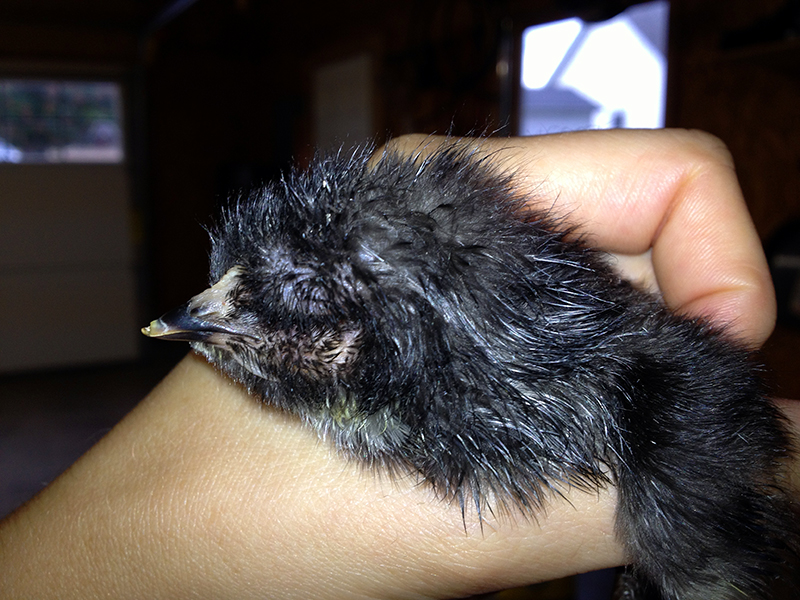
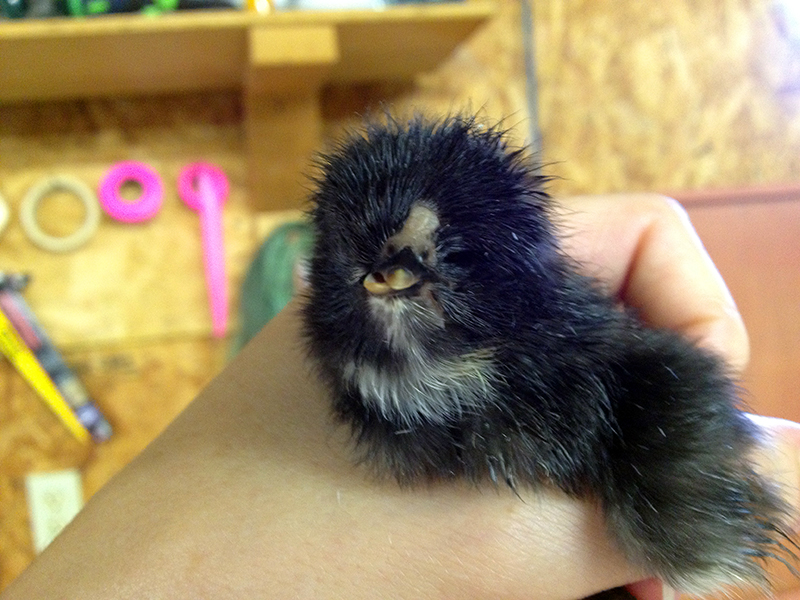
I suspect that there is no sight in its one eye, as it struggles to open that eye and doesn’t seem to respond to any visual stimuli.
I did some quick research and the prognosis isn’t good for a bird born with this defect. Some people can keep them alive with careful attention to making sure the bird gets enough to eat, but most people cull chicks born like this. That is what I plan to do.
The deformed chick, did, however, give me a good opportunity to get all six healthy chicks under Dahlia. I knew going into this that if I had just a few chicks, I would try to combine them under one hen. It didn’t make sense to double the work and cleanup of managing two coops of babies, and I knew that the older the birds got the more trouble I would have when it came time to combine both groups of babies. As I already know how potentially fraught introducing new birds to the main flock is, I wanted to minimize one extra step in the development of a new pecking order.
I chose to take the chicks away from Oregano because of the two birds, she seemed the less serious about mothering. She had pecked at the toes of the Coronation Sussex baby when it was brand-new, and today she was off the nest several times during the day, eating, drinking, and trying to dust bathe in the pine shavings. Not that one can blame her! Perhaps she knew the hatch was done and was trying to get her babies to follow her out to food and drink, but I didn’t get that sense from her.
I was stressed to put Oregano’s three chicks under Dahlia, but I did it one at a time and she didn’t bat an eye. The chicks dove right under her breast like they’d always been there, and there’s been no looking back. In fact, she led her babies off the nest this afternoon, leaving the deformed chick in the nest.
I took the unhatched eggs from Dahlia’s nest and added them to Oregano’s along with the deformed chick. I figured she’d go less crazy if she had a chick under her than if she had nothing and could hear chicks next door. But who knows, maybe she wouldn’t care? Anyway, the plan now is to give any remain eggs another day under Oregano to try to hatch, though I doubt any will, and then return Oregano to the main flock. Which might be tough if they see her as an intruder instead of a flock mate. Geez—managing these birds can really be a pain!
But if I get Oregano back with the flock, I should be in the clear. Dahlia can raise six chicks for as long as she likes, and I will deal with whatever comes next when it arrives. The good news is the six chicks now with Dahlia have spent the afternoon learning to eat and drink.
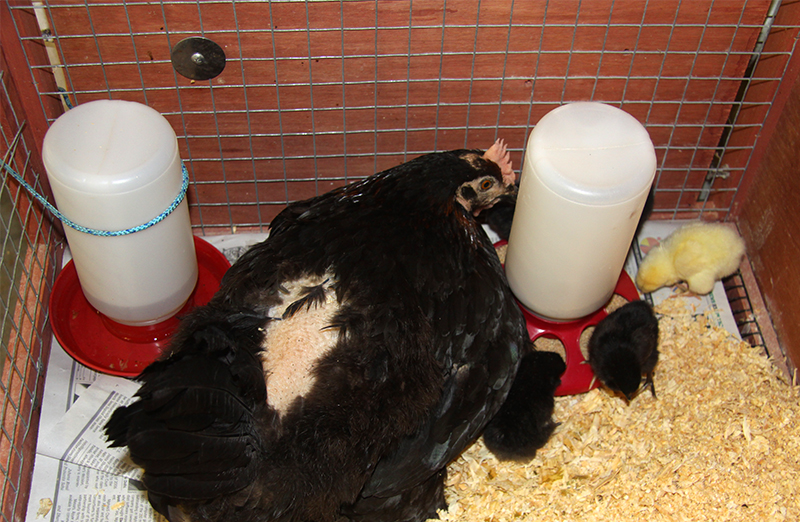
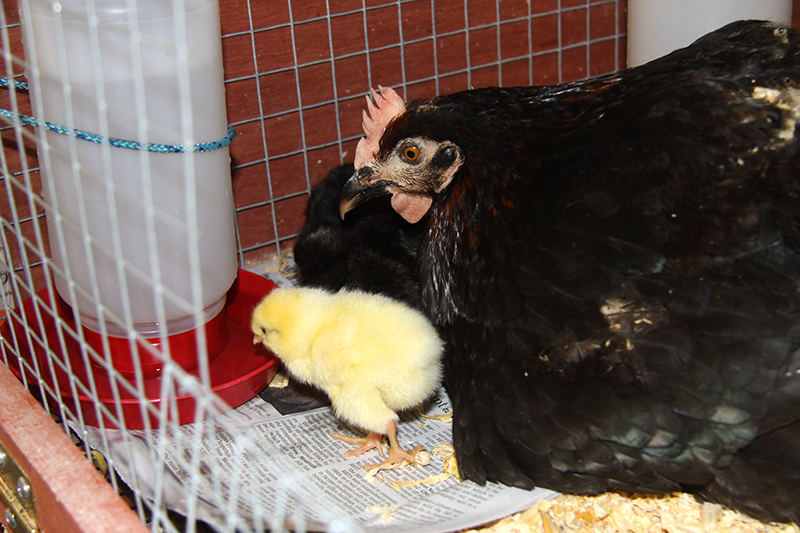
They are very active in the coop, pecking at everything including their mother’s comb (you can see a little blood spot in the photo above), wattles and even eyeballs, and seem healthy and happy. They run around, and when they are tired they dive into their mother’s feathers for a nap. Can you spot the stowaway?
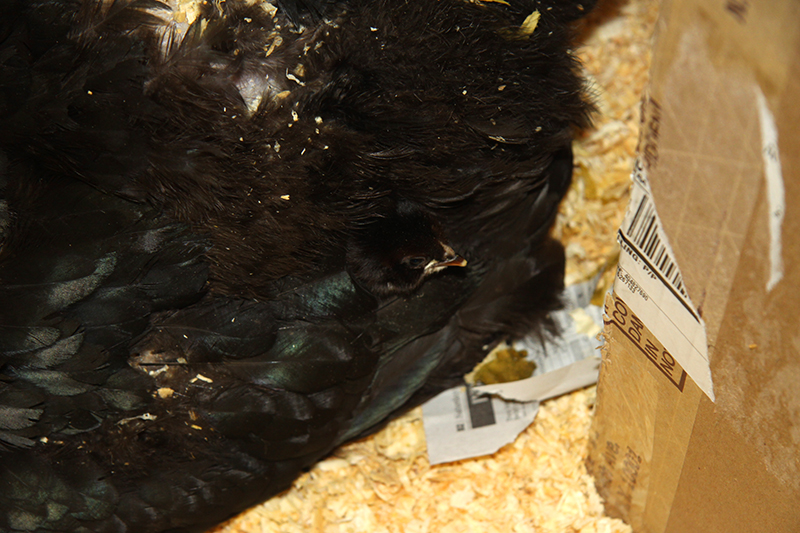
July 9th, 2013 §
There are new chicks, hatched early this evening, under both Dahlia and Oregano. Both are babies from Black Copper Marans eggs. Now each hen has three live babies, for a total of six on the ground. Oregano had one baby that pipped this evening, but it died before making it out of the shell. When I investigated, its yolk hadn’t yet been absorbed. I am starting to think the hot temperatures have affected this hatch, but that’s just a hunch and not substantiated yet with any research.

The chicks that were born last night are very active, hanging out at the front of the next box, pecking at shavings, and interacting with each other. Here are the yellow Coronation Sussex and the barred olive egger/wheaten Ameraucana boy.

They must be starting to think about food. Perhaps tomorrow they will take their first excursion out of the nest box. I am sure both mothers are also ready to get out of the nest. Notice how pale and dehydrated their combs and wattles are. Incubating eggs takes a lot out of a hen as they barely eat and drink just enough to keep from dying. They’ve both lost a bunch of weight—when I feel their chests all their breast muscle mass has shrunk away on either side of the keel bone.
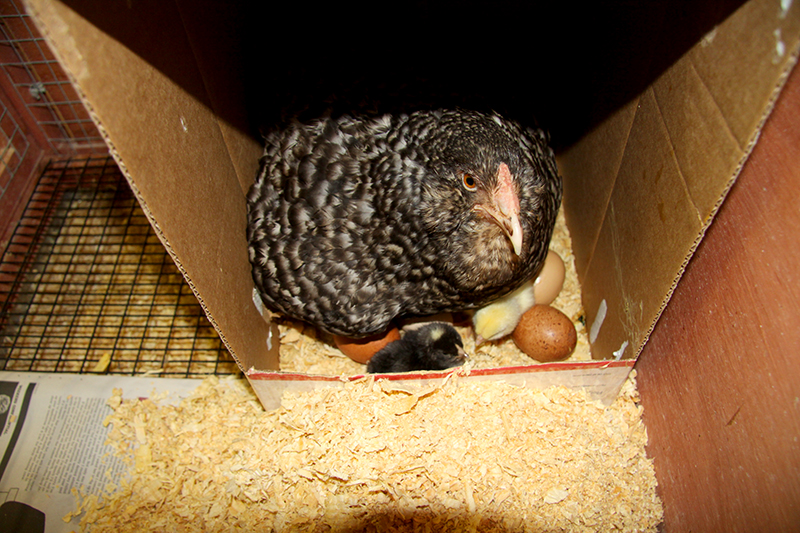
I find it interesting that when the guinea keets hatched last summer, they were way more active, way sooner than the chickens. The guinea keets were still wet from hatching and they’d already begun running out of the nest box. The chicks seem to be rather limp until they fluff up and find their legs. This little one under Dahlia has favored this front corner of the box all day. The chick has a few copper colored feathers, the same tone as mama’s, around its head and sides.
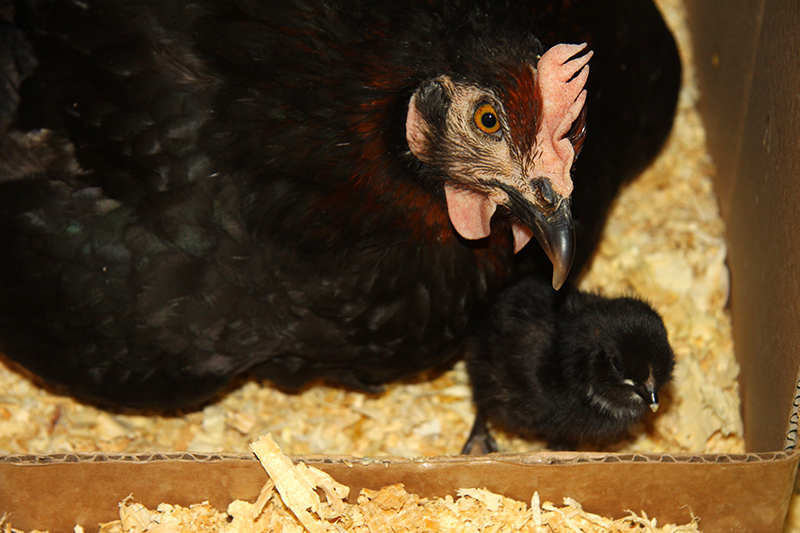
I suspect we might be done with this hatch. There aren’t any more pipped eggs, and nobody cheeped when I tapped on their shell. But we’ll see what the morning brings. I am ready to be done with this hatch phase, with its attendant death and stinky ooze, and on to seeing darling little fluff balls running all around the coop learning to be big chickens.
July 9th, 2013 §
At 8:00 a.m. I went out to check on the chicks. I heard peeping when I opened the garage door, so I knew there were babies somewhere!
Under Dahlia, two black chicks were just about all dried and fluffy. One came from a Black Copper Marans egg, which makes it an olive egger, and the other chick is Lilac’s baby. I saw one pipped egg but didn’t check them all.
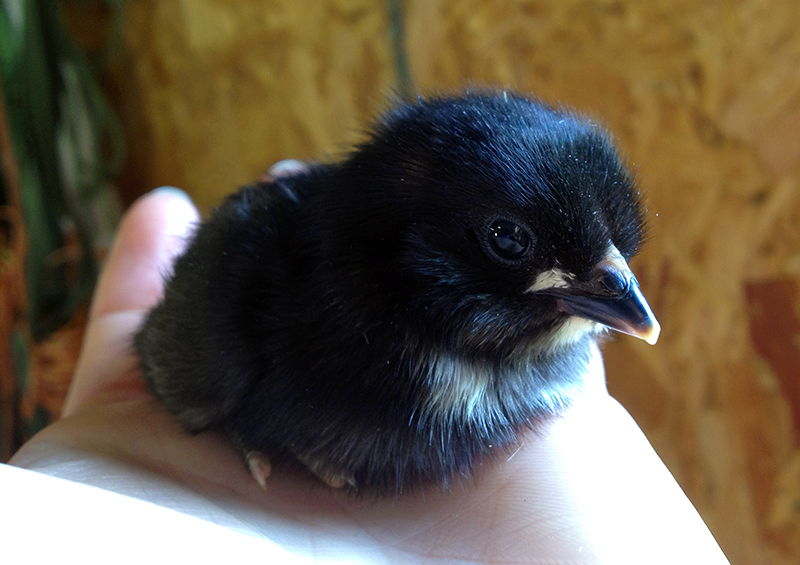
Under Oregano, the barred olive egger, there were two hatched chicks.
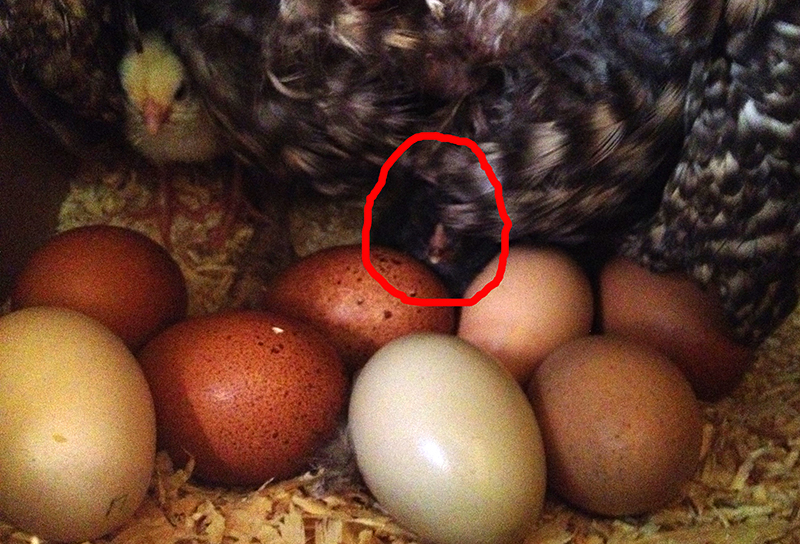
First up is a yellow Coronation Sussex baby!
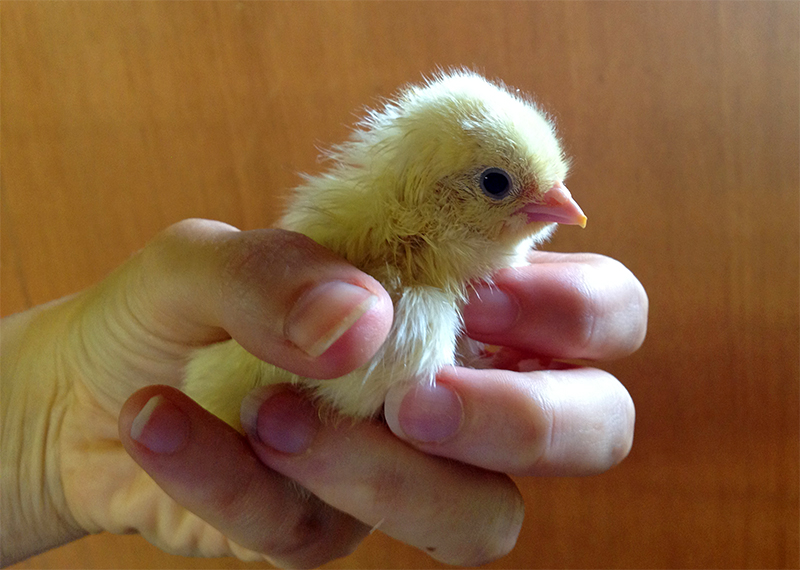
This is pretty exciting. And Oregano’s own egg, the one that journeyed to a Richmond refrigerator and back, had hatched during the night.
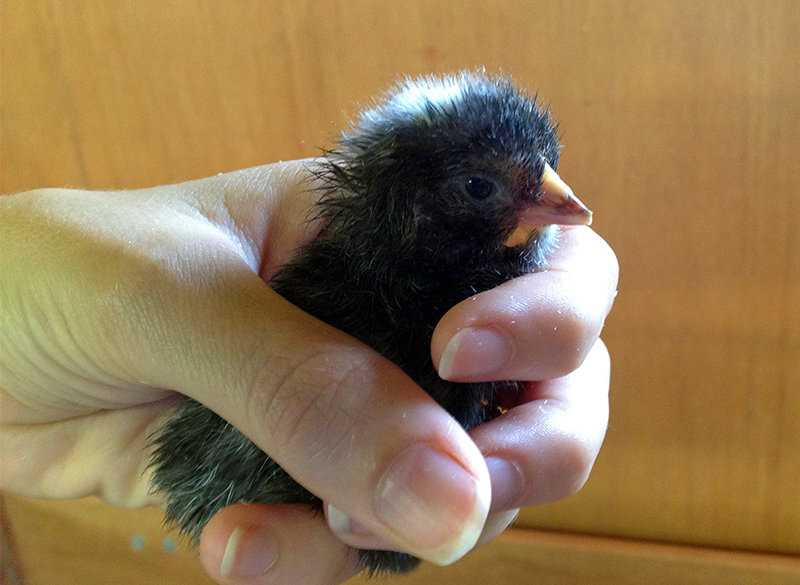
Unfortunately I think it’s a boy, as it has a white spot on its head, a sex-linked characteristic of barred breeds. Too bad I won’t get a chance at a super green egg layer this time around.
Meanwhile, here are the chicks’ empty eggshells. From top, the Coronation Sussex, then the barred olive egger, then Lilac’s egg, and finally a Black Copper Marans egg.
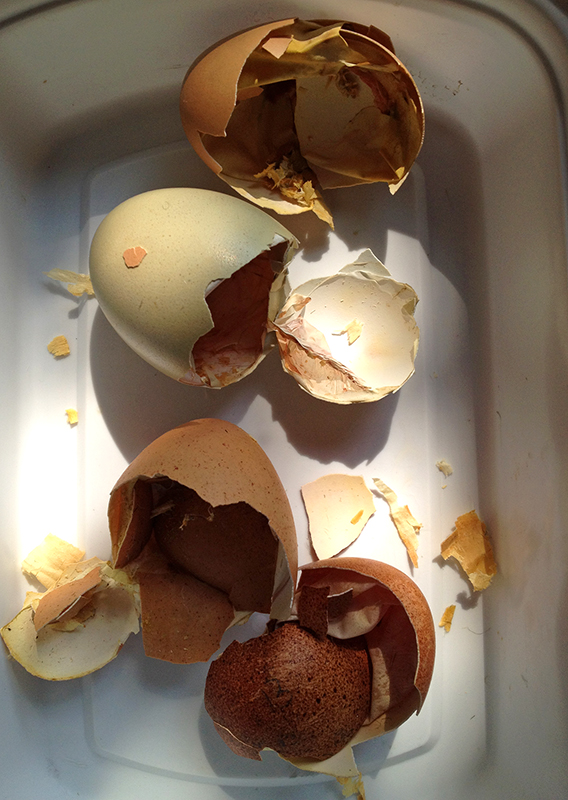
I saw another pipped egg in Oregano’s nest, so I left them in peace to continue hatching. There may be more babies to come, we’ll see.
July 8th, 2013 §
When I got Tuck in from his evening constitutional, around 10:30 p.m., I checked the nursery. There was a lot of action under Dahlia, lots of peeping and I saw a black chick partially emerged from its egg. Of course my phone battery was dead, so after it had charged up I headed back out, around 11:00 p.m., in hopes of getting a photo for you.

A chick! A real, live, healthy, vigorous chick! It obviously had a nice, quick, clean hatch, and was moving around like crazy. In the light of the flashlight, which I held in my mouth to take these photos, it bobbed and ducked and cheeped and burrowed deeper under Dahlia. She seemed to regard it with benign curiosity. Like, what is that? It’s a good thing she will have the whole dark night to get used to the idea of being a mother. Which she will be several times over, if the noises on her nest are any indication.
You can also see in the photo above the egg, on the right, that was pipped in my last post. Not too much development there.
Over in Oregano’s coop, it was much quieter. But, her egg, the olive egg, was definitely progressing. This is somewhat amazing as this is an egg that I put in a carton, carried in a warm car down to Richmond to give to my brother to eat, where it spent several days in a refridgerator before I realized Oregano had gone broody and ceased laying. This egg, and another that traveled with it, plus one I still had at home, were her only hope of biological offspring. So my brother carefully packaged the eggs for a return trip via my dad to Charlottesville, where I placed them back under their mother. One olive egg disappeared during incubation, and the other came up clear when I candled it. Thus I had zero expectation that through all this jostling, temperature change, etc., this egg would hatch, but here it is, tonight, with a peeping baby inside.

And here’s another egg, still pipping and making progress:

All eggs went immediately back under their mothers, and I came in to write this post before bed. I’d be lying if I said my heart didn’t stop seeing that healthy, wet baby under Dahlia. I am not the fainting type, but I felt lightheaded and swoony. I guess that’s what happens when you’re face to face with brand-new, much-hoped-for life. I could only imagine what it would feel like to see one’s human baby. If my reaction to new-born chickens is any indication, am not sure my heart would survive the crush of emotion.
I hope that the first check in the morning reveals nests full of fluffy, healthy, hungry chicks. That is my dream for tonight.
July 8th, 2013 §

Today is day 20 for the eggs that are incubating under the broody hens. Last night I discovered another broken rotten egg under Dahlia, the Black Copper Marans, and had to clean that up.
I check the nests this morning, just by listening for peeping, and heard nothing. Then tonight at 6:00 p.m. I went out and saw that Dahlia had thrown one of the remaining Coronation Sussex eggs (two others had already broken during incubation) out of the nest, most likely because she knows it’s not viable.
I heard very faint peeping and took a quick peep under Dahlia’s breast feathers. There I found this dead chick. It appears perfect (look at those toenails, that egg tooth, the cornsilk feathers) except in one vital way. It’s yolk is not entirely absorbed into its belly. Where there should be a clean, dry shell after a hatch this one is a mess of blood and yolk. And its eyes are still sealed shut. It appears that this baby came too early. Not sure why. Could be the hot temperatures, who knows? Perhaps Dahlia even killed it, as some first-time broodies will. I removed it from the nest, Dahlia pecking at it as I dug its sticky body out of the pine shavings.
It’s a sad way to begin the hatch, but beyond my control. By the way I am not posting photos here to gross anyone out. I am posting them because I find a ton of wonderfully educational information on blogs. What “ordinary people” write is often more relevant and specific than the information I find on formal educational sites (for example, the .edu party line is that chicken eggs hatch in 21 days. But because of reading blogs about other hatchers’ experiences, I learned that eggs under broody hens usually hatch on the evening of day 20. And here we are, hatching on the evening of day 20). I hope that by describing and photographing this hatch someone else may benefit from my experience or be able to leave a comment that educates me about how I can do something better in the future.
But back to the coops. There are still signs that more chicks are trying to hatch. Here’s a pipped Black Copper Marans egg.
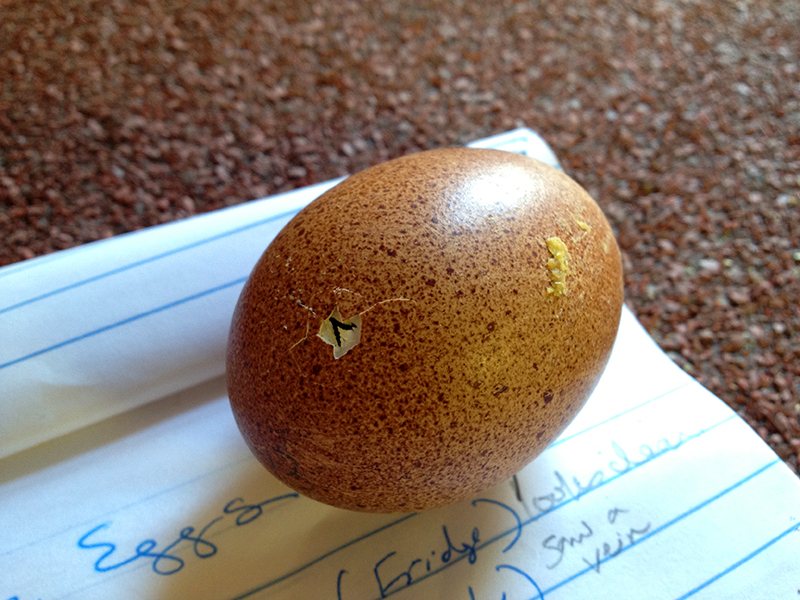
This chick is inside, faintly peeping, and I could feel and see it move through the hole. I put it quickly back under its mother and checked Oregano, the barred olive egger, very fast.

I could see under her feathers that two eggs had pipped, but I didn’t dig around exploring. Now isn’t the time to fuss anyone up, especially with one already dead hatchling, so I am going to leave them alone and hope that I wake up in the morning to some live babies.
July 7th, 2013 §
The “Glass Gem” corn is now taller than I and just beautiful. All this rain has created a great year to trial corn for the first time. And I am definitely seeing the benefits of all the soil building I have done during the last three years. Thus far the insect pest load seems lighter than in years’ past, which is a good indication that the plants are healthy enough to defend themselves. Running the chickens in the garden during the winter probably helped too, as they no doubt ate up overwintering eggs and larvae.
I had a moment of sheer joy the other day when I went to transplant a dahlia into the veg garden. My shovel blade sank all the way into the soil without any effort from me. This is nothing short of a miracle given the solid, almost impenetrable clay soil I began with. Now if only the soil in the ornamental garden around the house was in such good shape. I still need a pickax to plant in it, and my plants suffer for it.
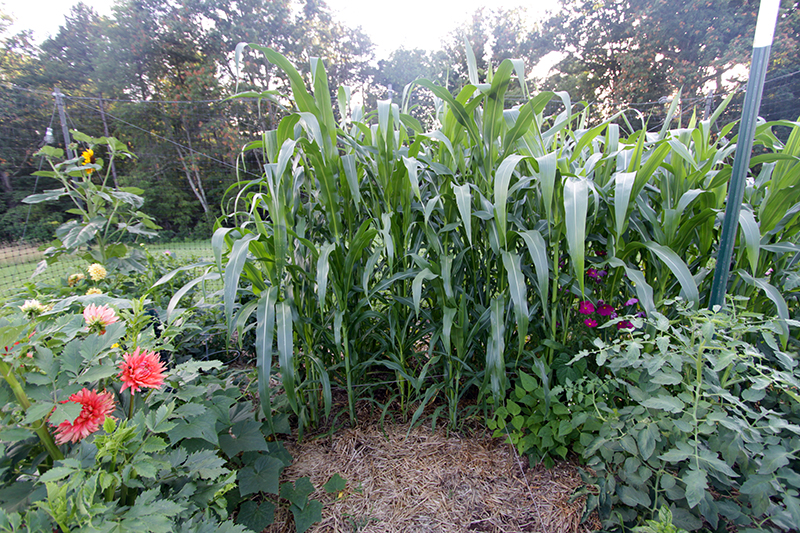
Corn and beans and cosmos
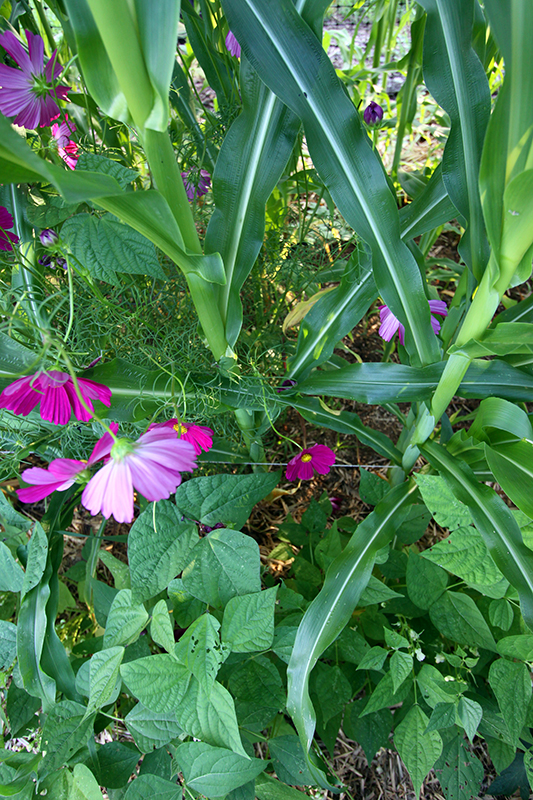
Several of the dahlias are now blooming. Starting them in March really gave me a huge jump on the season, and I think the second-year tubers are also quicker to get out of the ground than first-year tubers. Makes sense. When I dug some of my first-year tubers last fall, what began as a piece the size of my thumb had, in some cases, become a clump so large I needed two hands to hold it. All that stored energy has got to go somewhere, and thus the big, early plants I am seeing this year.
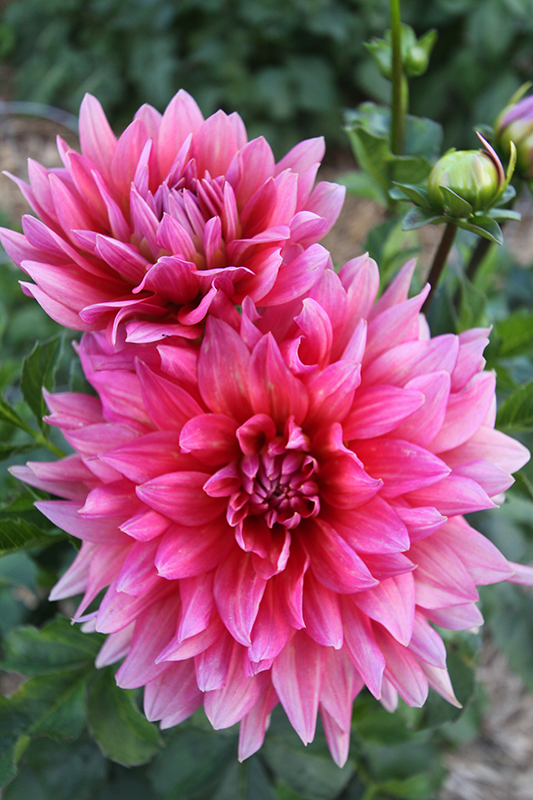
I love being able to have beautiful cut flowers whenever I want them. It’s one of the best things about summer.
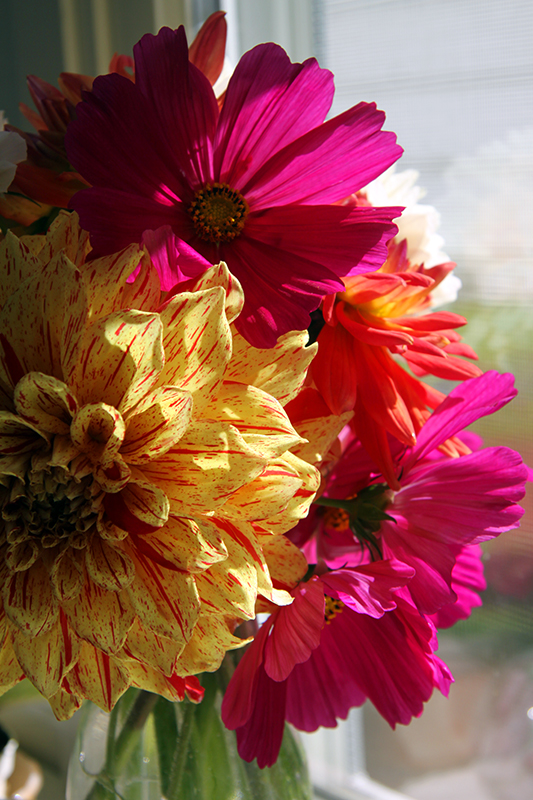
Finally, I am starting to see progress with the plantings around the front of the garden, where I haven’t developed the soil. I stuck some lavender in there last year. It’s horrible soil for lavender, straight clay that holds water all the time. I lost several lavender plants over winter to these poor growing conditions, but a few came back and have bloomed. In the holes made by the dead laveneder I planted some of last year’s bee balm, just chunks I hacked off a main plant that overwintered in a bucket behind the shed with no love from me. Well, each hunk has turned into a good-sized plant and they’re blooming. Everything planted out here needs to be unpalatable to deer and attract more pollinators. I definitely am on the right path now with the lavender, bee balm, and a bit of cat mint. Soon the sunflowers planted within the garden, just in front of the tomatoes, will bloom and join the party.
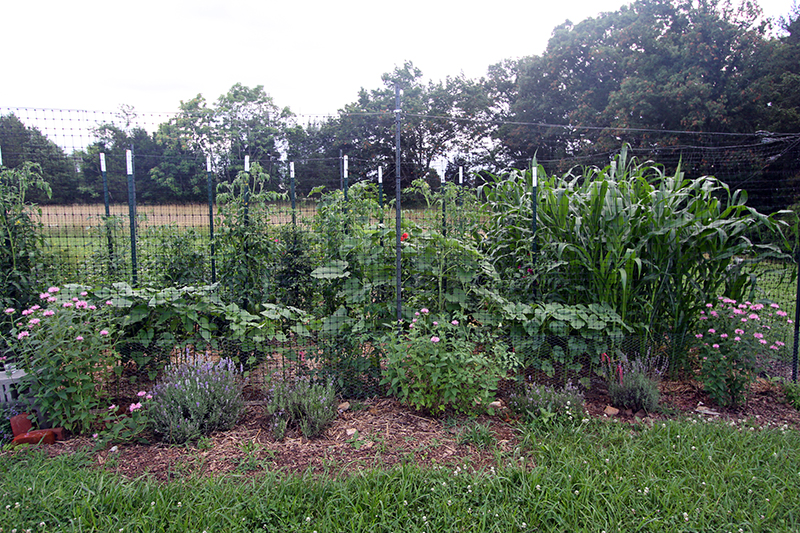
July 6th, 2013 §
We’ve had an unusual, for here, weather pattern during the last few weeks. It’s been raining almost every day, and the air is humid soup. All growing things look great, lush and happy to have all this moisture during a time when we are usually headed into summer drought. I haven’t had to water the garden once in at least a month, and most everything looks very good.
This year I am experimenting with letting some things go to seed. Chard, with its yellow feathery seedheads below, is a biennial. I planted these last year, overwintered them in pots, and now they’re in the garden working on setting seed. It’s a sacrifice to devote square footage to plants that are going to seed, but I am curious to see if I can begin to be less dependent on store-bought seed. I hope that certain things, most especially greens and lettuces, will start self-sowing in the garden, which means less for me to buy, plan and plant each year. And, once plants take control of their own growth cycles, instead of relying on a fallible gardener to tell them when to grow, they usually are much happier and healthier.
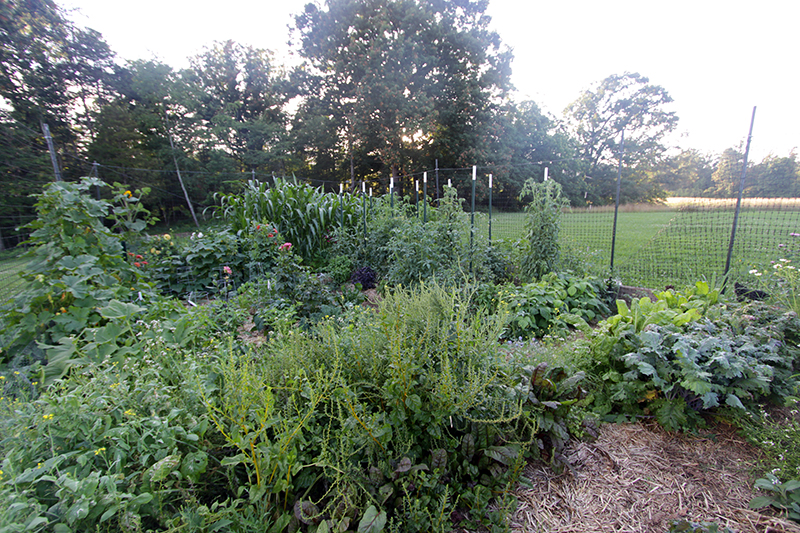
No Fourth of July ripe to tomatoes for me, but the plants are full of green fruit.
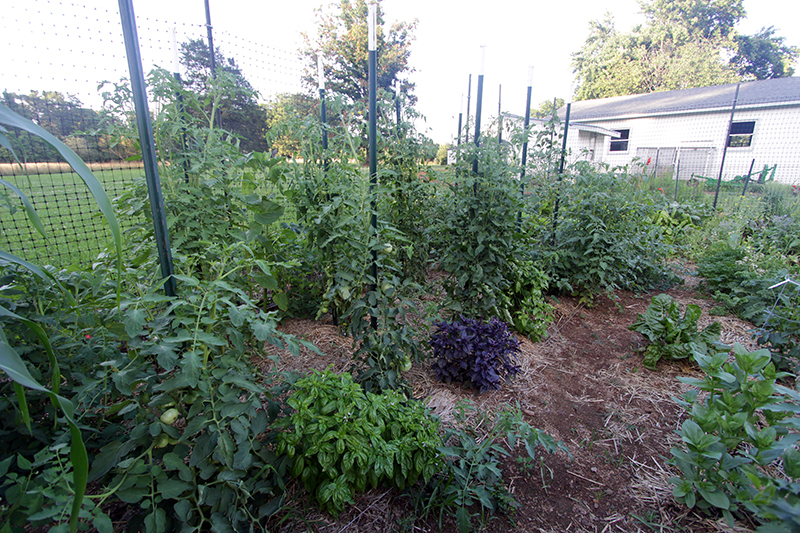
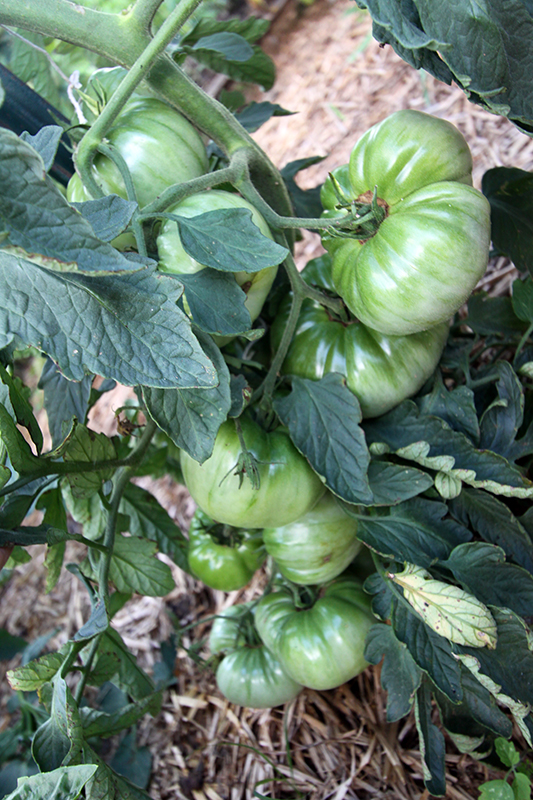
The Sun Sugar cherry tomatoes are just starting to ripen.
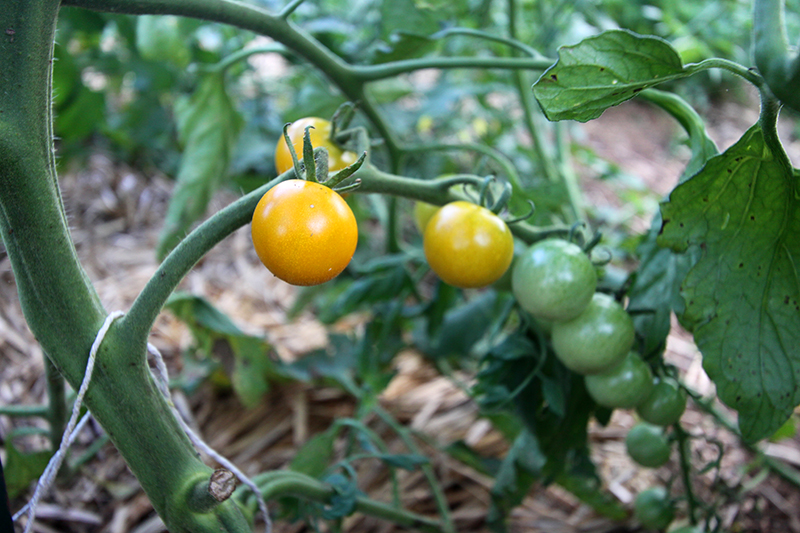
The only downside to all the rain is that it creates good conditions for diseases such a blight and fungus. You can see the beginnings of some blight at the base of this tomato in the yellowing, withered leaves with dark necrotic spots. Nothing to do but remove the affected leaves from the garden to help slow the spread. Some people use chemical sprays to control disease, but they’re an absolute last resort for me and I haven’t used them yet in this garden. Compared with some of my gardening friends, whose tomato plants are already halfway yellow, I am doing okay. I think my planting and mulching practices are paying off.
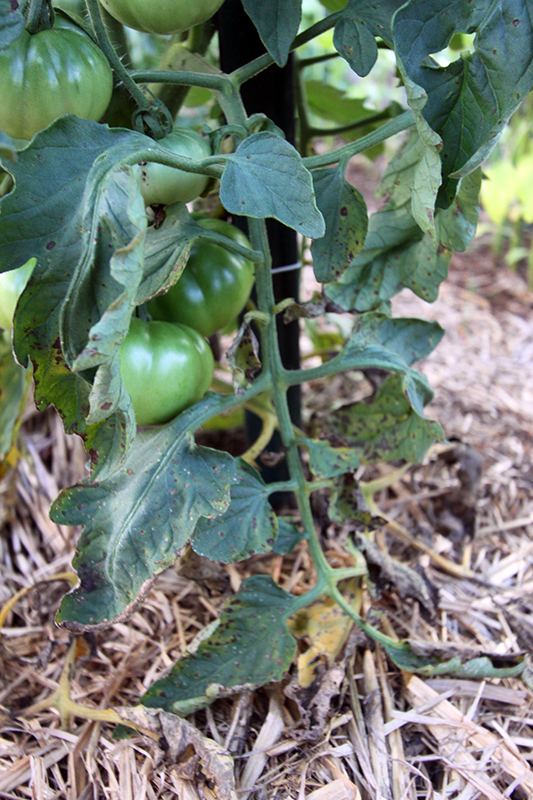
I ripped out the pea vines, which were done for the year, and planted some rattlesnake beans in their place to grow up the trellis. I have never grown these particular beans, but I hear they are pretty great. The big green plant to the right is a volunteer shiso, a wonderfully fragranced Asian culinary herb. I have no idea where the shiso came from—perhaps a neighbor—but it pops up all over my property. When I finally recognized what it was, I let it grow out everywhere as an ornamental.

I think it’s a very beautiful plant that seems to glow from within with a spiritual energy, similar to borage. It’s used in Japanese cuisine for all sorts of things. For example, the red shiso is used to make umeboshi, or pickled plums.
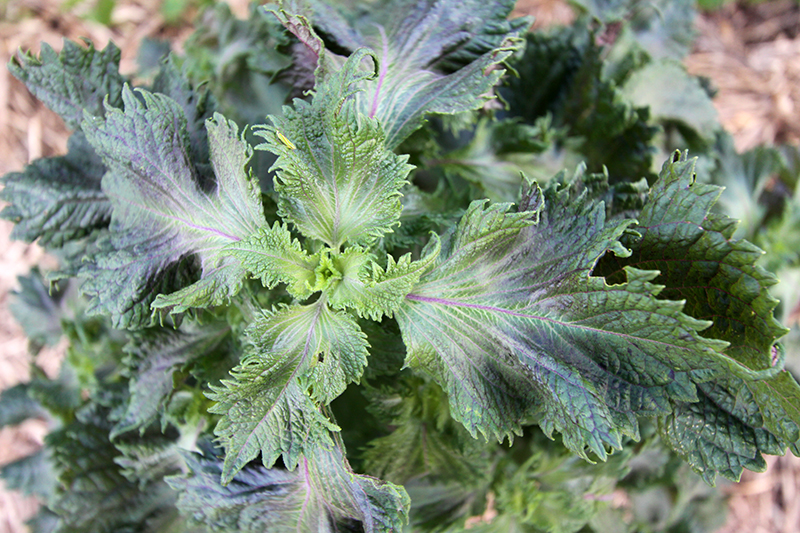
The volunteer vine that I thought was a squash turned out to be a pumpkin! Whoops! I had to cut this pumpkin off before it took down my fence. This plant may not be long for the world anyway as it appears the squash bugs have now discovered it.
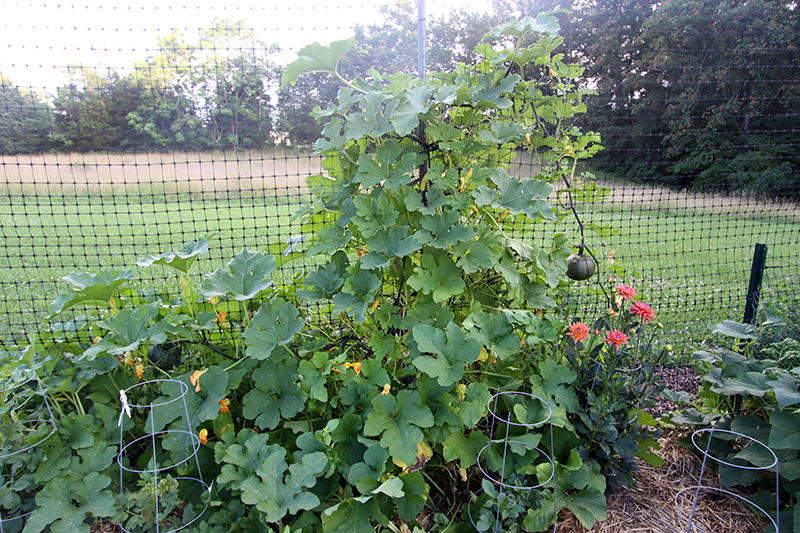
I am drowning in cucumbers. Which is kind of fun as I am on a quest to find the best refrigerator pickle recipe. Any suggestions?
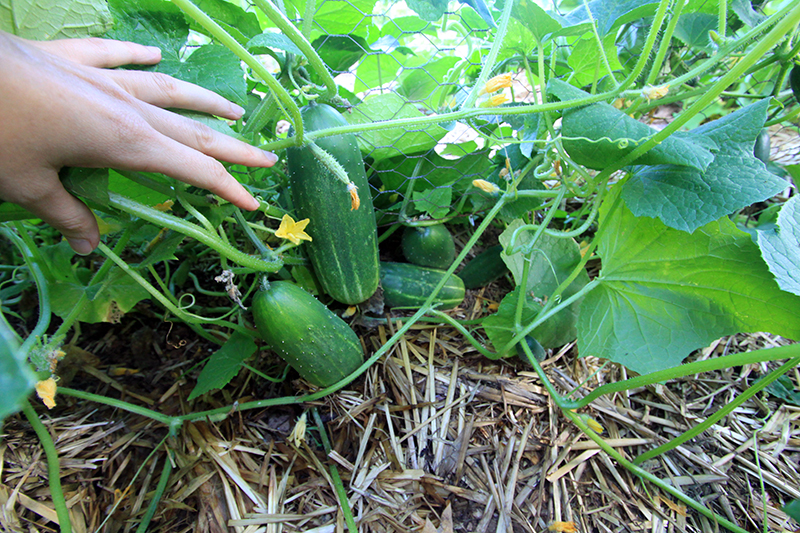
And, because it seems that cucumbers in my garden come on strong before petering out, I started a few more plants up the other former pea trellis. I planted some fun ones I haven’t grown before including an Armenian, lemon, and just another regular old bush cucumber for backup.
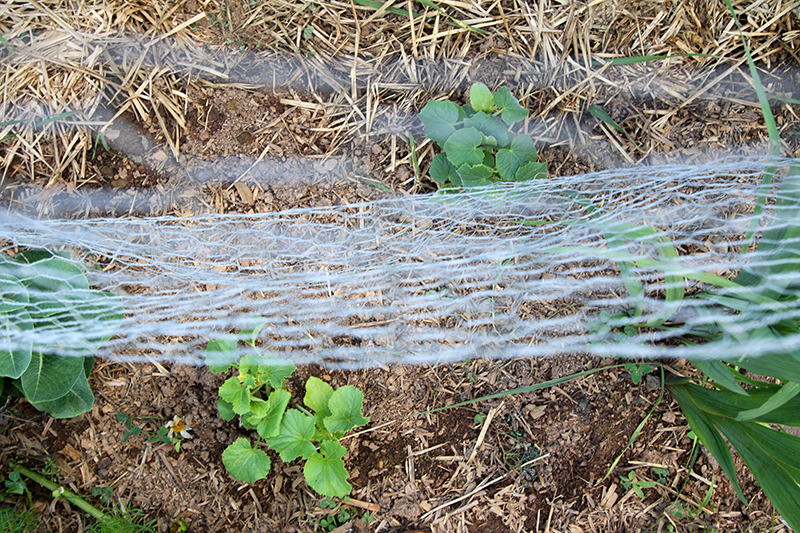
The only sweet peas to bloom from the dozens of started seeds. I think the trick to sweet peas is to plant them in the fall. Pretty pathetic. I will try that this year, as this is one flower I’d like to master.
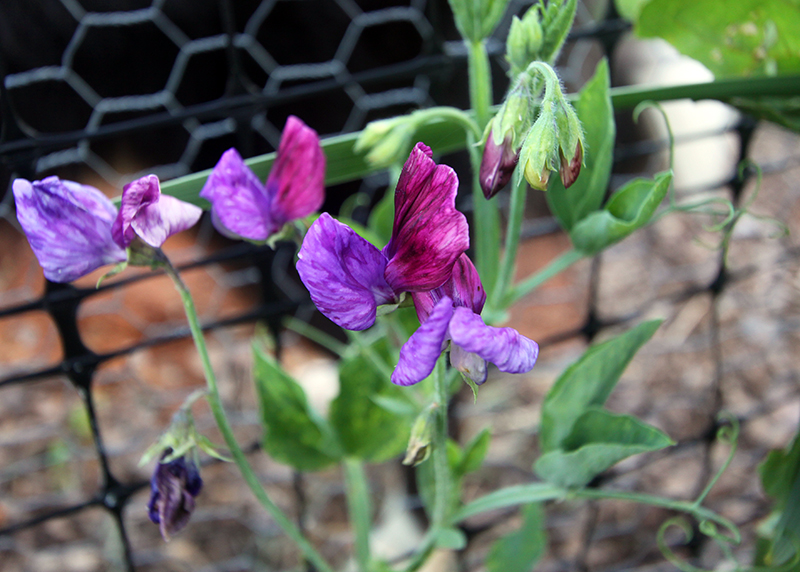
The Japanese beetles have arrived. They aren’t too bad yet, but maybe that’s because everyone I see gets a quick thumbnail through the thorax just before its tossed to a mob of chickens.

Up next, part two of the early July vegetable garden tour…
July 4th, 2013 §
I was walking with Tuck near here the other night and came across the most beautiful butterfly in the middle of a gravel road. It was one I didn’t recognize, which is always exciting.

It was dark in the woods so this butterfly’s colors are hard to see, but it was the most amazing shade of navy blue fading into bright, iridescent turquoise. I’d never seen a live butterfly in this particular color. True blue (not purple-blue) is such a rare color in the natural world that it doesn’t seem real when one sees it.
I very gently coaxed it on my hand so I could move it off the road, and saw its underside was equally beautiful. Sorry for the unintentional flip off—that was the finger it chose!
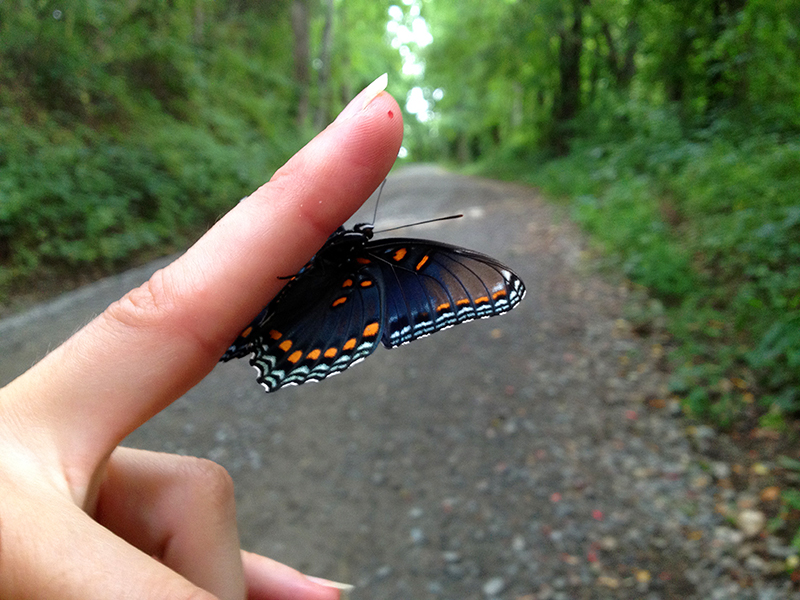
After taking these shots so I could ID the butterfly later, I put it on the bank and went on my way, very, very happy to have seen for just a few minutes something of such incredible beauty on my evening walk.
The trip was made even more joyful when I flushed a few quail out of a hedgerow beside the road. This was wonderful to see as quail are really in trouble in Virginia. The Department of Inland Game and Fisheries reports, in their Northern Bobwhite Quail Action Plan for Virginia:
Populations of northern bobwhite quail and other bird species with related habitat requirements have experienced severe long-term declines in Virginia over the past 50 years. In colonial times, farming created habitats that began to favor quail. As land was cleared and farmed, quail populations flourished. For perhaps 200 years or more, quail were one of the most common birds of the rural Virginia landscape. During the first half of the 20th century, as a shift from a rural-farm to urban-industrial economy began, idled and abandoned farms continued to support quail populations. However, since then major land use changes have taken place. Virginia’s agricultural landscape became dominated by large, intensively managed crop fields, fescue pastures, and hayfields.
Total farmland acres declined. In 1900, approximately 80% of Virginia’s landscape was in open agricultural land. Today agricultural lands make up only 34% of our landscape. Many of the formerly open farm fields are now dominated by intensively managed pine forests. While cut-over timber lands still provide some early-succession cover, plant diversity is low and productivity for quail is poor. The loss of early succession habitat, particularly nesting cover and brood range, has been identified as the most significant factor limiting quail populations. The bobwhite is a legacy species in Virginia and their decline has led to concerns about ecological, economic, and recreational impacts throughout rural Virginia.
Anytime you can spot a threatened species in the wild is encouraging. It makes me glad to live in an area that’s still suitable to sustaining important wildlife biodiversity.
But back to butterflies…at home I got out my field guide and opened right to the page with this butterfly on it. Weird. Anyway, it is a red-spotted purple, which is supposedly common in this area though I have never come across one until now. Strange name, too, for a blue butterfly with orange spots!
And then yesterday I was walking in the house and saw a red-spotted purple flying in my flower garden. Now that I know what it is, it’s easy to identify by its more rounded lower wings that lack the extended hind wings that identify swallowtails, below:

(Image source: http://www.edupic.net/lifecycle.htm)
And that’s your daily lepidoptery lesson, with a little quail digression!












































